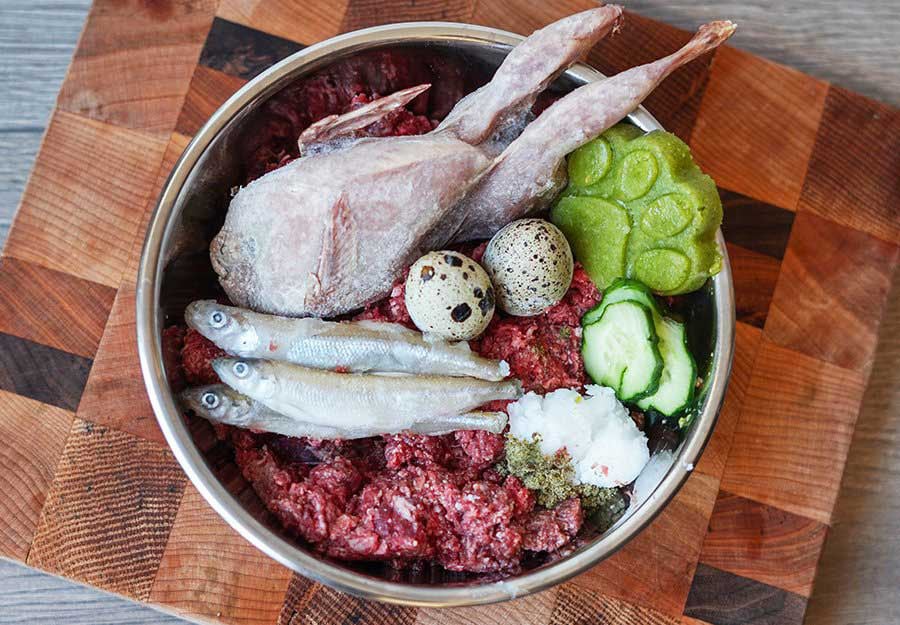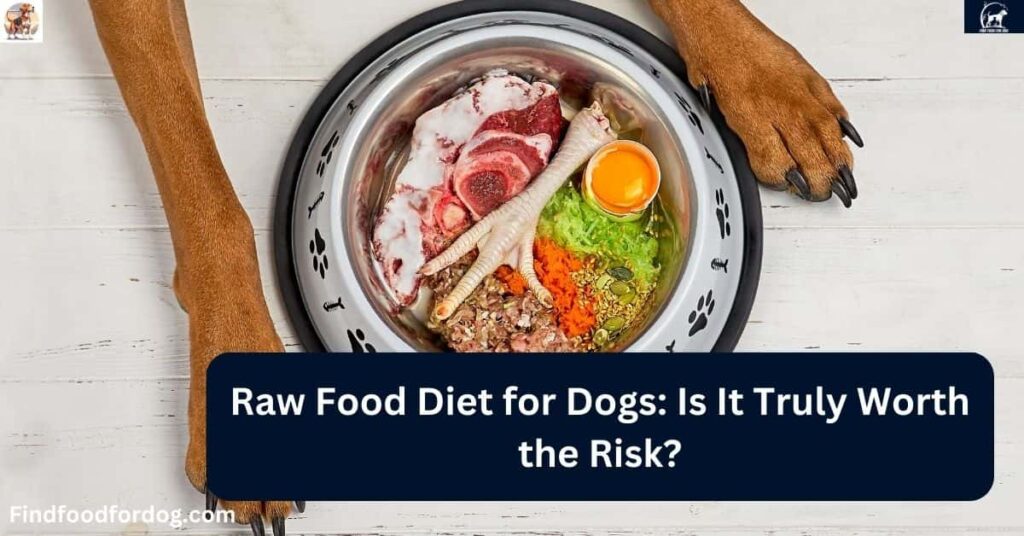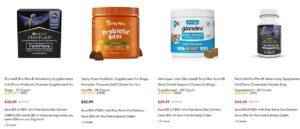Raw food diet recipes for dogs include fresh meat, fruits, and vegetables. These recipes promote optimal health and vitality in pets.
The raw food diet for dogs focuses on providing natural, unprocessed ingredients that mimic a dog's ancestral diet. Pet owners increasingly turn to this approach to enhance their furry friends' well-being. Fresh meats, organ meats, and bones form the basis of many recipes, along with dog-friendly fruits and vegetables.
This diet aims to improve digestion, boost energy levels, and support a healthy coat. Crafting balanced meals requires careful planning to ensure dogs receive all necessary nutrients. Many owners enjoy experimenting with various ingredients, tailoring meals to their dogs' preferences and health needs. Exploring raw food recipes can lead to healthier, happier pets.

Customize Homemade Dog Food
Introduction To Raw Food Diets For Dogs
Raw food diets for dogs focus on natural, uncooked ingredients. These diets often include meat, bones, fruits, and vegetables. Many pet owners choose this diet to promote better health. Understanding the basics can help you decide if it's right for your furry friend.
Benefits For Your Furry Friend
- Improved Digestion: Raw diets can enhance digestive health.
- Healthier Coat: Natural oils from raw food promote shiny fur.
- Better Energy Levels: Dogs often feel more energetic and playful.
- Stronger Teeth: Chewing raw bones helps clean teeth.
- Weight Management: Raw diets can aid in weight control.
Common Misconceptions
Many myths surround raw food diets for dogs. Here are some common misconceptions:
| Myth | Truth |
|---|---|
| Raw diets are unsafe. | With proper handling, raw food can be safe. |
| Dogs will not get enough nutrients. | Balanced raw diets provide all necessary nutrients. |
| All dogs can eat raw food. | Some dogs may need special diets. |
Understanding these points helps clarify the raw food diet. Always consult a vet before making changes to your dog's diet.
Essential Components Of A Balanced Raw Diet
A balanced raw diet provides dogs with the nutrients they need. Proper balance ensures good health and vitality. Focus on three main components: protein, vegetables, and supplements.
Protein Sources
Protein is crucial for your dog's growth and energy. Quality protein sources include:
- Raw meat: Chicken, beef, lamb, turkey
- Fish: Salmon, sardines, mackerel
- Organs: Liver, kidneys, heart
Mix different protein sources for variety. This helps avoid nutrient deficiencies.
Vegetables And Fruits
Vegetables and fruits add fiber and vitamins. They support digestion and overall health. Choose these safe options:
| Vegetables | Fruits |
|---|---|
| Carrots | Blueberries |
| Spinach | Apples (remove seeds) |
| Sweet potatoes | Bananas |
| Green beans | Watermelon (remove seeds) |
Chop or puree vegetables and fruits for better digestion.
Supplements And Minerals
Supplements help fill nutritional gaps. Include these:
- Fish oil: Supports skin and coat health
- Probiotics: Aids digestion
- Calcium: Essential for bone strength
- Vitamins: Ensure a balanced intake
Consult a vet before adding supplements. They can guide you.
Getting Started: Transitioning Your Dog
Transitioning your dog to a raw food diet can be exciting. This change brings health benefits. It requires careful planning. A smooth transition helps your dog adjust easily.
Step-by-step Guide
Follow these steps for a successful transition:
- Consult Your Vet: Talk to your veterinarian first.
- Choose a Protein: Start with chicken, turkey, or beef.
- Start Slow: Mix raw food with current food.
- Gradually Increase Raw Food: Slowly reduce the old food.
- Watch for Reactions: Monitor for any digestive issues.
Be patient. Each dog adjusts at their own pace.
Monitoring Your Dog's Health
Keep an eye on your dog's health during the transition. Here are key factors to monitor:
| Health Factor | What to Look For |
|---|---|
| Digestion | Check for loose stools or constipation. |
| Energy Levels | Notice any changes in activity or playfulness. |
| Skin and Coat | Look for changes in coat shine or dryness. |
| Weight | Monitor weight gain or loss. |
Adjust the diet based on your observations. Regular vet check-ups are important.

Customize Homemade Dog Food
Simple Raw Food Recipes
Feeding your dog a raw food diet is simple and nutritious. These recipes are easy to make. They use fresh ingredients that support your dog's health. Here are two simple recipes: one with chicken and the other with beef.
Chicken-based Feast
This recipe is packed with protein. It’s perfect for active dogs. Follow these steps to make a tasty meal.
- Ingredients:
- 2 cups raw chicken (boneless)
- 1 cup carrots (chopped)
- 1/2 cup spinach (fresh)
- 1/4 cup blueberries
- 1 tablespoon fish oil
- Chop the chicken into small pieces.
- Add chopped carrots and spinach.
- Mix in blueberries and fish oil.
- Serve fresh and enjoy the tail wags!
Beef And Veggie Mix
This hearty recipe combines beef with healthy veggies. It’s great for dogs of all ages. Here’s how to prepare it.
- Ingredients:
- 1 cup ground beef (raw)
- 1 cup broccoli (chopped)
- 1/2 cup sweet potato (cooked and mashed)
- 1/4 cup pumpkin puree
- 1 tablespoon olive oil
- Brown the ground beef in a pan.
- Add broccoli and cook until tender.
- Mix in sweet potato and pumpkin puree.
- Drizzle with olive oil before serving.
These simple raw food recipes are a great start. Your dog will love the flavors and nutrients!
Specialty Recipes For Dietary Needs
Dogs with specific health concerns require special attention in their diet. A raw food diet can be tailored to meet these needs. This section focuses on recipes designed for dogs with allergies, sensitivities, and senior dogs. Each recipe provides essential nutrients while considering your dog’s dietary restrictions.
Allergies And Sensitivities
Many dogs suffer from food allergies and sensitivities. Common allergens include grains, chicken, and beef. Here are some raw food recipes that cater to these needs:
- Turkey and Veggie Mix
- 1 lb ground turkey
- 1 cup chopped carrots
- 1 cup chopped spinach
- 1 tbsp fish oil
- Fish and Sweet Potato Delight
- 1 lb salmon (boneless)
- 1 cup mashed sweet potatoes
- 1/2 cup peas
Both recipes are free from common allergens. They provide vital nutrients while ensuring your dog enjoys their meal.
Senior Dogs
Senior dogs often have different dietary needs. They require easily digestible foods. Here are some tailored recipes for older dogs:
| Recipe | Ingredients |
|---|---|
| Chicken and Pumpkin Mash |
|
| Beef and Quinoa Bowl |
|
These recipes help maintain a healthy weight. They support joint health and provide energy for your senior dog.
Meal Prep And Storage Tips
Preparing raw food for your dog can be fun and rewarding. Meal prep and storage are essential for maintaining freshness and safety. Follow these tips to make the process easy and efficient.
Batch Preparation
Batch preparation saves time and ensures you have meals ready. Here are some simple steps:
- Choose Recipes: Select a few raw food recipes your dog loves.
- Gather Ingredients: Buy all necessary ingredients in bulk.
- Set Aside Time: Dedicate a day for meal prep each week.
- Chop and Mix: Prepare and mix ingredients according to your recipes.
- Portion Control: Divide meals into daily servings for easy access.
Safe Storage Practices
Storing raw dog food safely is crucial. Use these practices:
- Use Airtight Containers: Keep food fresh and prevent contamination.
- Label Containers: Write the date and contents on each container.
- Refrigerate Immediately: Store food in the fridge right after preparation.
- Freeze Extra Portions: Store surplus meals in the freezer for later use.
Here's a quick reference table for storage times:
| Storage Method | Duration |
|---|---|
| Refrigerator | 3-5 days |
| Freezer | 2-3 months |
Take advice from Pet Expert Dr Marty
ESA Pet is an online service that helps you get a legitimate ESA letter
Pet vitamin supplements and grooming products
Following these meal prep and storage tips keeps your dog’s food safe and nutritious. Enjoy the process and watch your furry friend thrive!
Cost Analysis: Raw Diet Vs. Commercial Foods
Understanding the costs of a raw food diet for dogs is essential. Many pet owners wonder if the benefits outweigh the expenses. Let’s break down the costs involved in raw feeding compared to commercial foods.
Budgeting For Raw Ingredients
Raw diets require specific ingredients. Budgeting is crucial for success. Here’s a breakdown of potential costs:
| Ingredient | Average Cost (per week) | Notes |
|---|---|---|
| Meat | $30 | Choose quality cuts. |
| Vegetables | $10 | Opt for organic when possible. |
| Supplements | $5 | Include necessary vitamins. |
| Total | $45 | Weekly cost for raw diet. |
Buying in bulk can lower costs. Local farmers and co-ops might offer discounts. Seasonal vegetables can also save money.
Long-term Health Cost Benefits
Investing in a raw diet can reduce long-term health costs. Healthier dogs often need fewer vet visits. Here are some potential benefits:
- Fewer allergies and skin issues
- Better dental health
- Increased energy levels
- Longer lifespan
Consider the average vet costs over time:
| Health Issue | Average Cost (per visit) |
|---|---|
| Allergies | $150 |
| Dental Cleaning | $300 |
| Obesity Treatment | $200 |
Investing in a raw diet may lead to fewer health issues. This can save money in the long run. Consider this when deciding on your dog’s diet.
Faqs And Troubleshooting
Transitioning your dog to a raw food diet can raise questions. Here are some common concerns and solutions.
Handling Picky Eaters
Picky eaters can make meal times challenging. Here are some tips to encourage your dog:
- Mix flavors: Combine different proteins like chicken and beef.
- Add toppings: Use healthy toppings like bone broth or yogurt.
- Warm it up: Slightly heating the food can enhance the aroma.
- Routine: Feed at the same time daily to create a habit.
- Patience: Give them time to adjust to new foods.
Watch for changes in your dog's appetite. Adjust recipes accordingly. Keep trying different combinations until you find what excites their taste buds.
Dealing With Digestive Issues
Some dogs may experience digestive problems during the diet switch. Common issues include:
| Issue | Solution |
|---|---|
| Diarrhea | Gradually introduce new foods over a week. |
| Vomiting | Reduce portion size and feed smaller meals. |
| Gas | Introduce new proteins slowly to avoid gas buildup. |
Monitor your dog's stool consistency. Adjust the diet if needed. Consult a vet if issues persist. They can provide tailored advice.
Frequently Asked Questions on Raw Food Diet for Dogs Recipes
What Is A Raw Food Diet For Dogs?
A raw food diet for dogs consists of uncooked meats, fruits, and vegetables. This diet aims to mimic what dogs' ancestors ate in the wild. Proponents believe it promotes better health, improved digestion, and shinier coats. Always consult a vet before making dietary changes for your pet.
Are Raw Food Diets Safe For Dogs?
Raw food diets can be safe if properly managed. Ensure you use high-quality ingredients and maintain hygiene. Some dogs may have specific health issues that make a raw diet unsuitable. Always consult your veterinarian to determine the best option for your dog’s health needs.
What Recipes Can I Try For My Dog?
You can try simple recipes like raw chicken with vegetables or beef and sweet potato mix. Other options include fish with leafy greens or turkey with carrots. Always introduce new foods gradually. Monitor your dog for any digestive issues or allergies when trying new recipes.
How Do I Transition My Dog To Raw Food?
Start by mixing raw food with your dog’s current diet. Gradually increase the raw portion over several days. Monitor their reactions and adjust accordingly. Ensure you maintain a balanced diet with essential nutrients. Patience is key; some dogs adapt quickly while others take longer.
Customize Homemade Dog Food
Conclusion
A raw food diet can be beneficial for your dog’s health and energy levels. By incorporating fresh ingredients, you can enhance their overall well-being. Try the recipes shared in this post to give your furry friend a nutritious boost. Healthy dogs lead to happy owners.
Start your raw food journey today!














